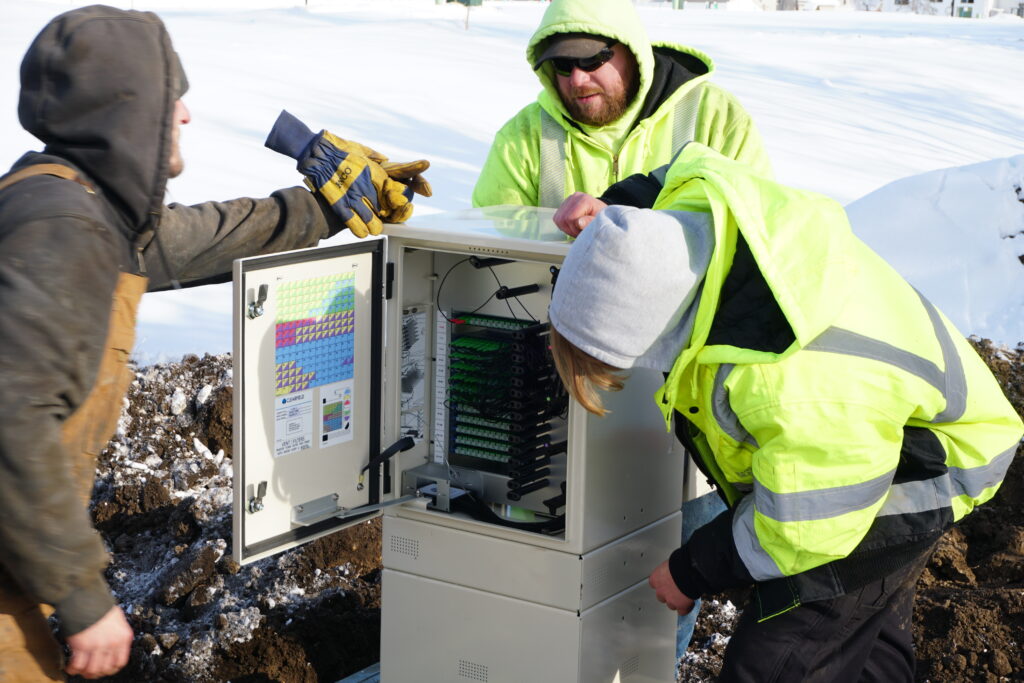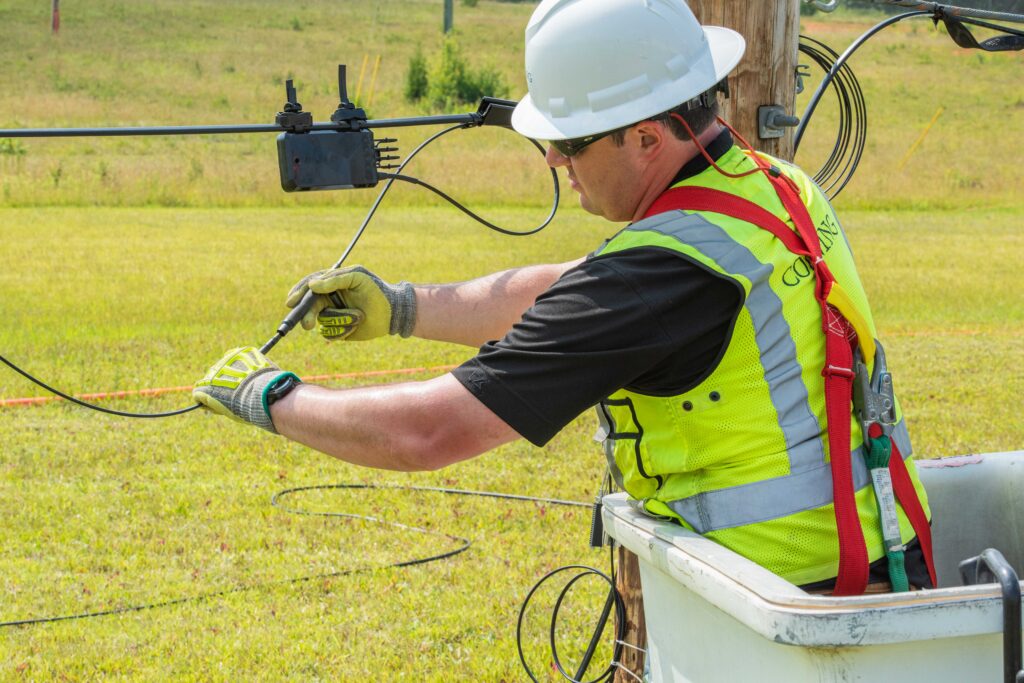Prepping Fiber for Faster Deployments
Early fiber deployments were dependent upon field technicians pulling, cutting, and splicing fiber for everything, leading to bespoke networks as finely tailored as a customized suit and just as expensive and time consuming to build. With the cost of labor making up 80% of a fiber build, the need for faster planning, deployment, and connecting homes and businesses is always at top of mind.
Contractors and service providers alike have one eye on the budget and another eye on the calendar, as financial stakeholders want the network completed on time and budget (preferably ahead of schedule and under budget), so customers can be turned up as quickly as possible to generate revenue. Meanwhile, long-awaiting customers who have seen the construction crews on the streets disrupting traffic and tearing up roads want high-speed broadband connected as quickly as possible, especially those who have suffered through service interruptions and sub-par speeds from legacy or no infrastructure.
The fiber industry is well aware of these pressures and over the years, has continuously rolled out improvements to processes and new products to increase the speed of fiber deployments and lower labor costs. For many service providers, plug-and-play pre-terminated connectors, pre-loaded reels, and cassettes are among the many tools used to light homes and businesses faster. There are numerous solutions available from multiple vendors, providing healthy competition and continuing to drive innovation in the market.
To be sure, there are as many “perfect” solutions for contractors and service providers as there are service providers. One-size doesn’t fit all, doesn’t have to, and shouldn’t, since every fiber operator will have its own preferences and ways of doing things, based upon its culture, history, and budget. Fiber Forward interviewed Clearfield, Corning, and Lightera (formerly known as OFS ) to get a flavor for what is possible today and what we might see in the pipeline in the future to make everyone’s life easier when it comes to building a fiber network and connecting customers faster.
Prepopulate and Prepare
Saving network construction time can take place anywhere within the build timeline, but certainly one of the easiest wins starts at looking at the outside distribution plant at the edge of the network and avoiding as much on-site configuration as possible. Like buying a personal computer these days, it’s a lot less painful and faster to simply procure a cabinet off the shelf than custom build one, with the savings multiplying considerably when you have hundreds of cabinets to deploy and install throughout the network.
“Powered cabinets are kitted out at the factory,” said Michael Wood, Broadband Market Manager, Clearfield. “We’ve done all the thermal calculations, for example, so you don’t have to. We install all the power components, the power system required to run the electronics, as well as calculated the thermals required to exhaust the heat that they produce.”
Since everything is built and tested at the factory to exact specifications before shipping, the likelihood of success after installation and powered up is greatly increased. Technicians can spend relatively no time at a warehouse building and prepping cabinets for deployment and more time on connecting other parts of the network.

Buying and deploying a standardized cabinet type that is factory built, assembled, and tested saves significant time over in-house custom builds for every network location. (Source: Clearfield, Inc.)
The time savings gained by aligning on re-populated cabinets and other preconfigured solutions in the network flows into other parts of the build. “We provide templates for the concrete pad, so you know where to block off where to leave the opening for the cables entering and leaving the cabinet as well as cabinets that mate with our vaults, so that you don’t have to drill and cut with all that added hand work,” said Wood. “Again, saving time at the site.”
Many fiber plant providers also may provide specifications for their cabinets in electronic form that can be integrated into network construction management software. This helps with documentation, a vital if often overlooked aspect of the network lifecycle. Down the road, parts of the network will need to be repaired and upgraded and having the logged details of cabinets and other bits in the work will help reduce field time when maintenance is required.
Other areas where build time can be saved include drop reels pre-loaded with fiber, and those fiber cables pre-connectorized and tested at the factory, so technicians can simply plug in connections to the end of the network or individual homes without having to do that work or splicing in the field.
“That saves a ton of time, obviously, as well as sharing those [features] across different products by using the same standards,” said Wood. “And then, of course, the cassettes are used in cabinets and wall boxes and shared across applications as well. It’s that sort of flexibility and configurability that reduces warehouse inventory and makes it a lot easier to do a lot of different things with fewer products.”
Many fiber plant providers also may provide specifications for their cabinets in electronic form that can be integrated into network construction management software. This helps with documentation, a vital if often overlooked aspect of the network lifecycle. Down the road, parts of the network will need to be repaired and upgraded and having the logged details of cabinets and other bits in the work will help reduce field time when maintenance is required.
Plug and Play vs Splicing
Lightera’s service provider customers tend to choose between traditional splicing and pre-connectorized fiber, with plug-and-play solutions available from the curb to the home.
“Quite a few are electing to fusion splice,” said John George, Senior Director, Solutions Engineering, Lightera. “It depends on the capabilities of the service provider, their labor pool, their availability of fusion splicers, whether they will use hard splicing or a plug-and-play connectorized kind of drop. We offer both. While plug and play can save time, the cabling is more expensive. Our approach is to listen to the customer’s needs and recommend what we think might best meet their needs but let them ultimately decide the approach.”
Fusion splicing provides some advantages over plug-and-play solutions, with lower loss, higher performance, and higher reliability. Since the glass is directly fused together, connectors cannot get dirty or damaged during installation, preventing signal losses that could affect service turnup or future speed upgrades.
“The fusion splice machines are very inexpensive for drop applications,” said George. “You’re not going the have the same loss as a long-haul splicer, but it’s lower than a connector. Yes, someone has to be trained on it, but the new ones are fairly easy to learn. We have some service providers that do both [fusion and plug-and-play].”
Within the home, Lightera believes connectorized is a much better approach than splicing, because of the potential safety risks of glass shards and the simplicity and speed of being plug-and-play within the home.
Measure Twice, Cut Once
For service providers that really want to simplify their hands-on fiber labor, Corning offers a service that will custom cut cables to the needed length for the entire network and pre-connectorize the ends for rapid deployment and cost savings. “Just think of it as a factory-spliced cable assembly,” said Joe Jensen, Director of Market Development, Corning. “What we do is take the field splicing labor and replace it with factory splicing labor, which allows our customer to deploy up to five times faster. Our customers typically see $25 or more per home passed cost reduction, but it is usually much higher depending on the circumstances. That number will vary depending on geography, aerial vs underground and so forth.”
By replacing field work with factory work, Corning can reduce the onsite labor needed to deploy and connect fiber more quickly by working with the customer to get the planning and engineering more precise at the beginning through importing design data from network construction management software systems and simply measuring the distances between poles and handholds. Corning takes the provided data and builds the cable to the needed lengths with slack coils allowances added as needed, put connectors on it, tests everything at the factory to precise tolerances multiple times, and then ship it to where it is needed.
“This is a different workflow than a lot of our customers are used to,” said Jensen. “A couple of things change with this process. For instance, with traditional solutions, folks may just take the bulk cable and allocate it in the field, crews will install it, and they’ll take the measurements and record it in their [network documentation] when they get done. In our process, you need to go out and capture a little bit more data up front, because the information you’re giving us is to create the cable. It takes a lot of ambiguity out of the back end on the as-built. When you later go to do maintenance and repair, you know exactly what is out there.”

Pre-measured and preconnectorized fiber solutions custom built at the factory can significantly speed up network deployment, saving money and field technician time. (Source: Corning Incorporated)
When the cabling is deployed in the field, the connectorized fibers connect in minutes without the need for technician time to prep and splice the cable. Since every customized Corning cable built in this process is tested five times in the factory before it is shipped, the quality of cabling is verified before it arrives in the field.
Service providers can take and provide cable measurements in several ways, with some of the earliest methods very low tech. “We started with just rolling wheels off between poles,” said Jensen. “Then we moved into laser range finders like you might use on a golf course. If it’s a duct installation, you can use mule tape. A lot of our customers will give us a map from Google Earth that’s got the houses identified. We’ll do [estimates] with GPS coordinates and make it work.”
Measurement data can also be imported from GIS-based network construction management software packages like IQ Geo and Render. For the inevitable times when ideal CAD blueprints meet field reality, where measurements are off or cable otherwise needs to be moved and adjusted, Corning adds slack loops to the prepared cable at regular intervals and can also add “extension cords” if needed.
Having construction plans on file with Corning also provides advantages for restoration of services during extreme events. “We store our records for 10 years,” Jensen said. “During a hurricane or fire event, cables go down, poles get taken out. Customers can call us, and we can rebuild sections for emergency repairs, usually one or two cables. In those instances, we can typically do a two-to-three-day turnaround putting them at the front of the line. If instead they want to take splice in regular cables that’s fine too- our precon cables are made from regular cable types.”
Signal loss from using connectorized cable is minimal compared to the standard permissible ~30 dB dynamic range for a PON connection. “Our typical loss on these connectors is about 0.15 dB,” said Jensen. “You only have two or three connectors between the home and the OLT, so it’s very marginal.”
Extending fiber into MDUs and every room
Speed of installation concerns aren’t just limited to the outside of the home. Multi-dwelling units such as apartments, condominiums, and business towers present their own challenges. Tenants and owners alike don’t want the headaches and disruptions that come with having to fish cable through walls and ceilings and the noise and mess of drilling and cutting to deliver fiber withing an existing building. Meanwhile, service providers are embracing the value of locating fiber in a centralized location of the home, be it in an apartment or a standalone family residence, for optimum placement of Wi-Fi coverage.

Moving fiber from the traditional demark entry point to a more centralized location inside the home has become necessary in order to optimize Wi-Fi coverage in. (Source: Lightera)
Corning, Lightera, and others in the industry are using single and multistrand strand bend-insensitive fiber to deliver connectivity in MDUs and homes without the need for fishing, running it discreetly along a baseboard or molding and holding it in place using staples or an adhesive system to glue the fiber into place. The fiber end can be inserted into a surface mount wall plate adapter which provides a connection for the household ONT.
“We’re seeing increasing interest in these systems by service providers and homeowners to get that ONT/Wi-Fi unit located in the center of the house as much as possible to improve Wi-Fi coverage and avoid the need for a Wi-Fi mesh system,” said George. “People are paying for gigabit symmetrical service [that enters in through the standard telco demarc on the side of the house] and they’re measuring 500 Mbps, 200 Mbps or less a few rooms away or catty corner from the router. XGS-PON at 10 Gbps is where we are today, but 25 Gbps is rolling out and we’ll be at 50 and100 Gbps in the future. The consumer is paying for that fiber connection and expects not just high speeds but low latency. Latency suffers with Wi-Fi, especially with distances and walls and building materials affecting the signal along with retransmission of signals. Someone who is doing video calls or gaming wants the lowest latency possible. Fiber extended into the home and apartment can preserve speeds and latency to enable a better customer experience.”





